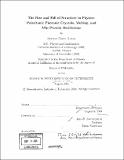The rise and fall of structure in physics : polaritonic photonic crystals, melting, and min-protein oscillations
Author(s)
Huang, Kerwyn Casey, 1979-
DownloadFull printable version (9.853Mb)
Other Contributors
Massachusetts Institute of Technology. Dept. of Physics.
Advisor
John D. Joannopoulos.
Terms of use
Metadata
Show full item recordAbstract
This thesis is a compilation of theoretical and computational work in condensed matter physics related to three topics in structure development. First, I study photonic crystals composed of polaritonic media, focusing on the unique features of the band structures and Bloch states in dispersive media with and without losses. I discuss three novel localization phenomena in these structures: node switching, flux expulsion, and negative effective permeability. Second, I examine the importance of surface interfaces to melting using density functional theory. I demonstrate that single-layer coatings of Gallium Arsenide on Germanium and vice versa have a huge impact on the substrate melting temperature, causing superheating and induced melting, respectively. Finally, I develop reaction-diffusion and stochastic models of the Min-protein oscillations in bacteria that reproduce all main experimental observations. These models explain the origin of instability that ultimately causes dynamic pattern formation and have successfully been used to predict nucleotide binding rates in E. coli. In round cells, I provide evidence that oscillations can be used as a general mechanism for protein targeting and detecting the cell's geometry.
Description
Thesis (Ph. D.)--Massachusetts Institute of Technology, Dept. of Physics, 2004. Includes bibliographical references (p. 187-197).
Date issued
2004Department
Massachusetts Institute of Technology. Department of PhysicsPublisher
Massachusetts Institute of Technology
Keywords
Physics.